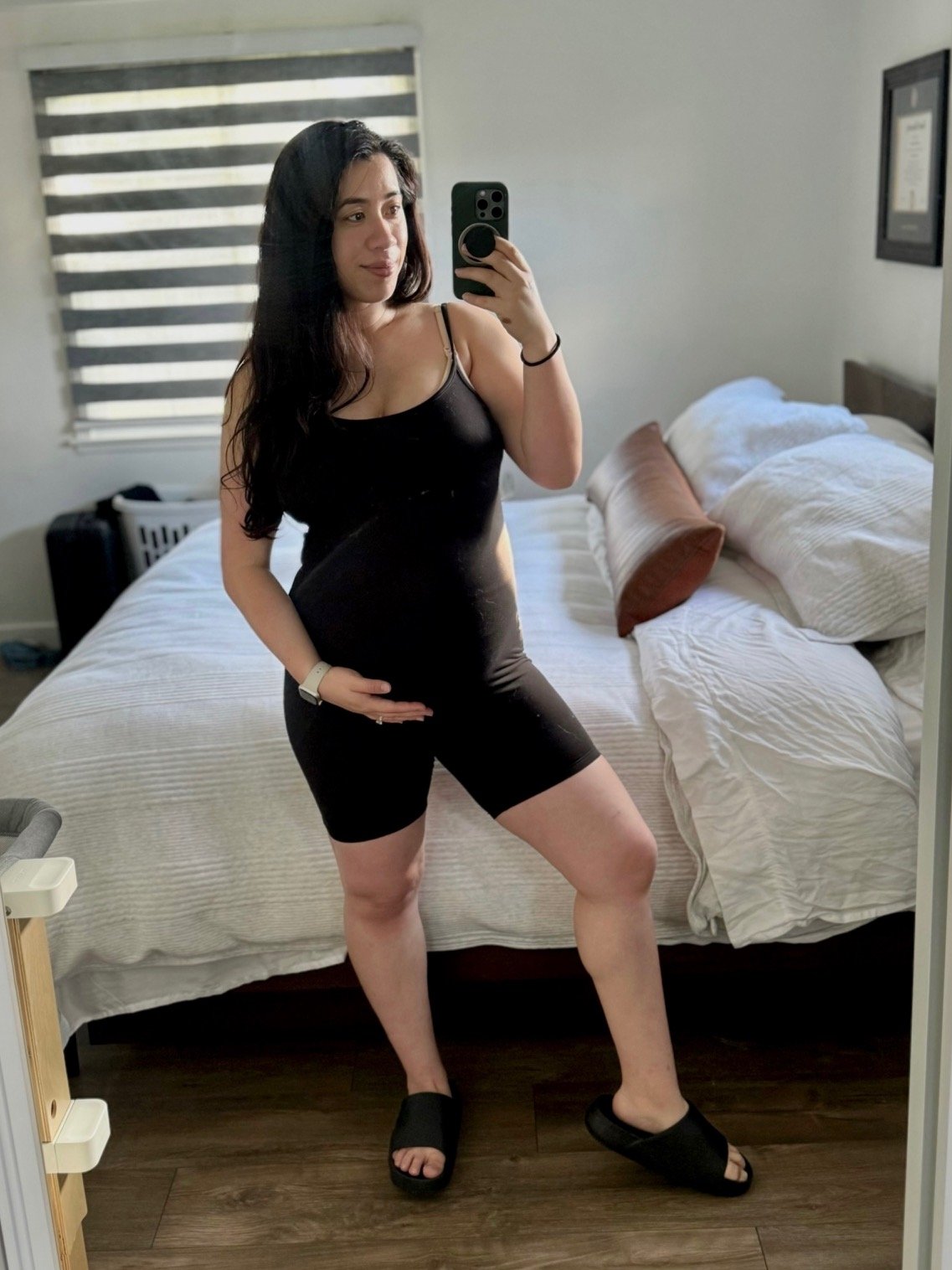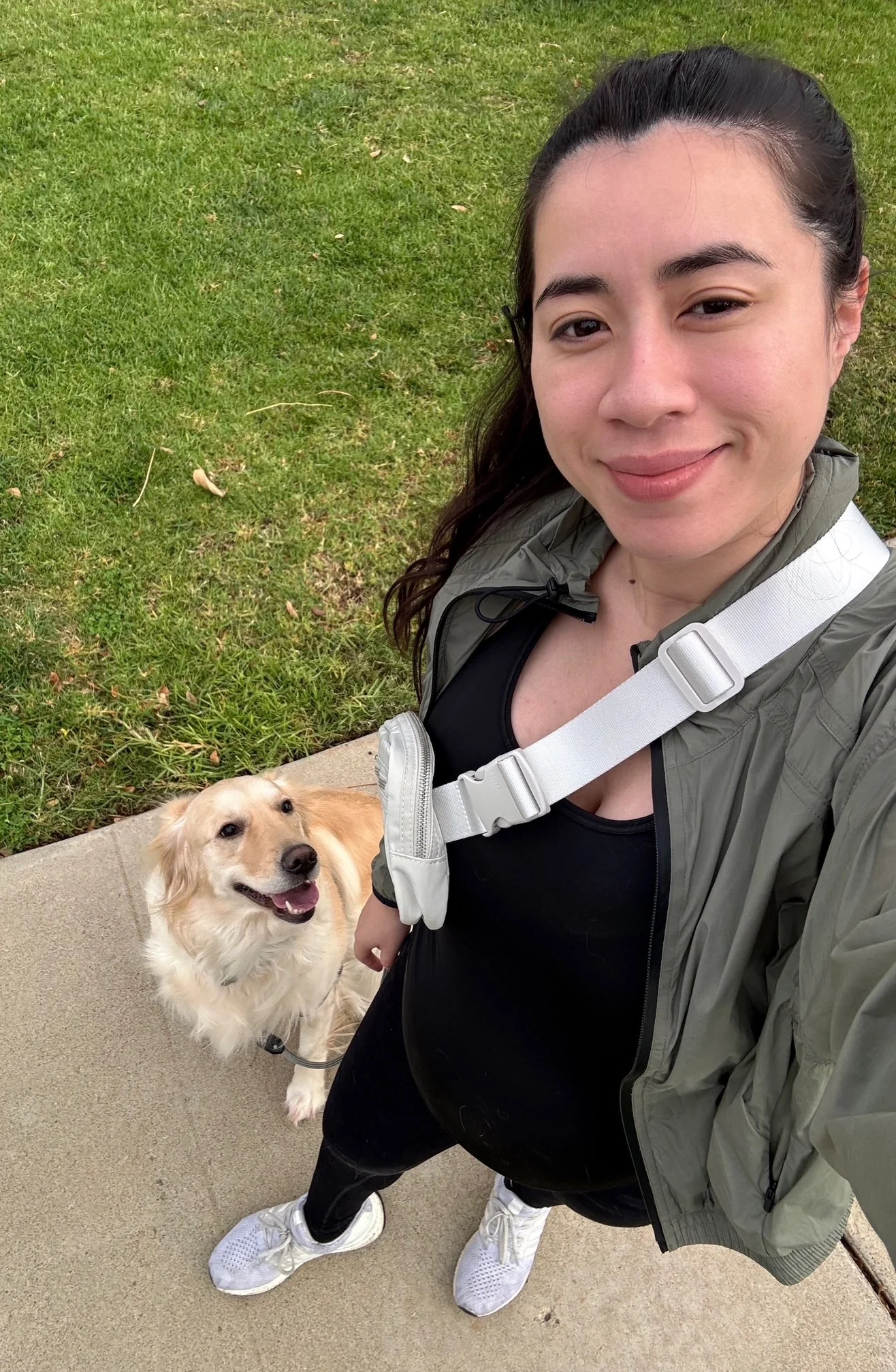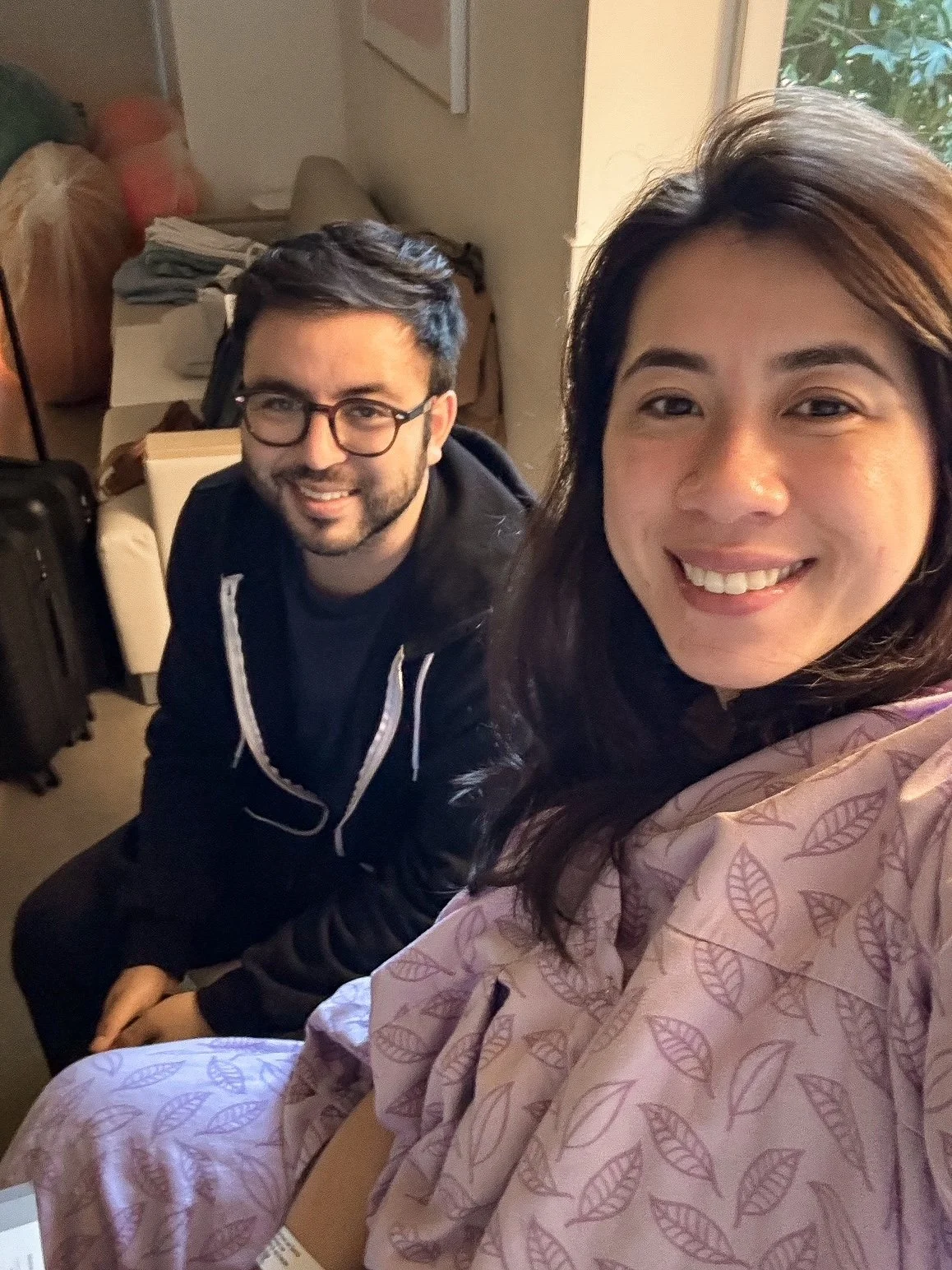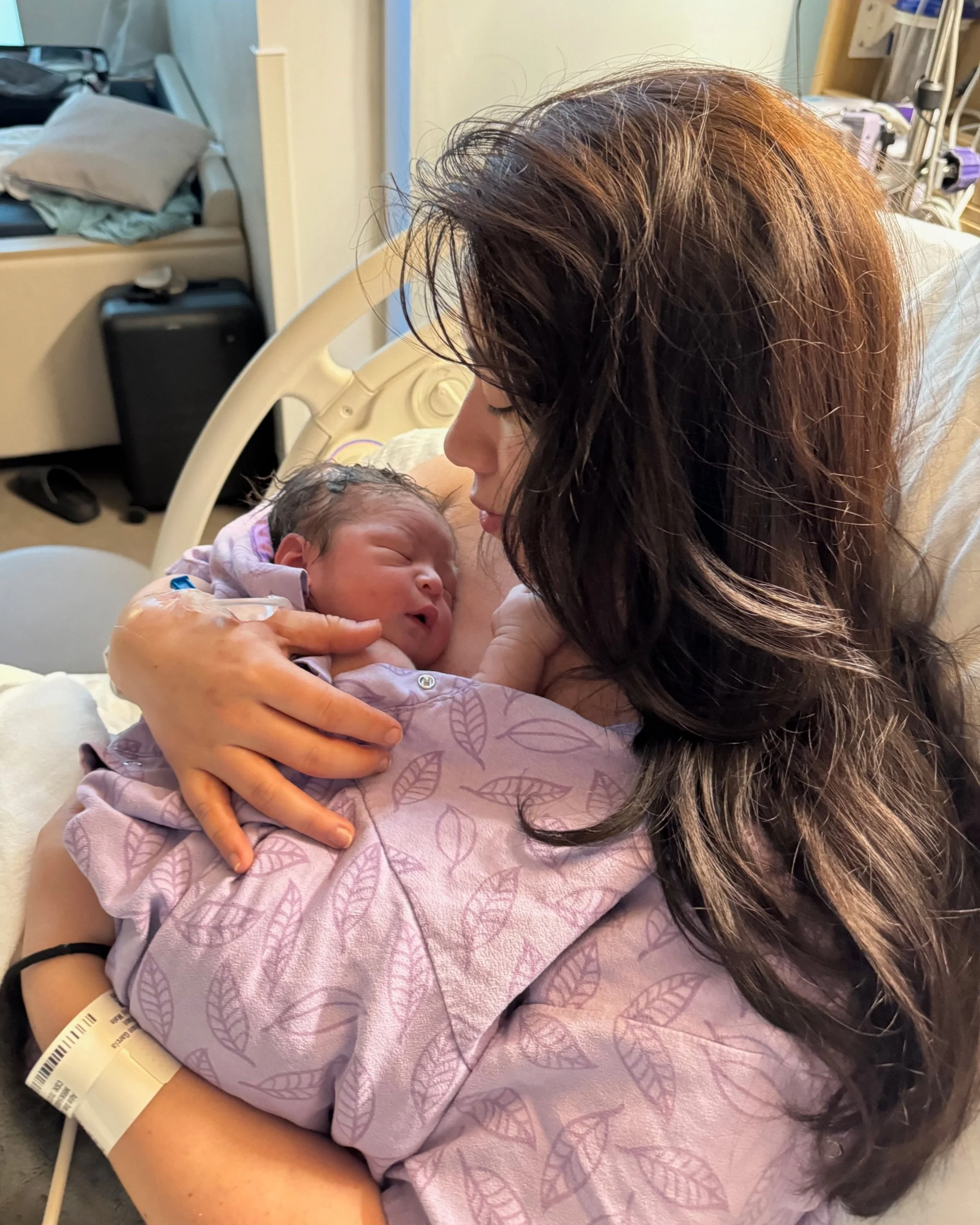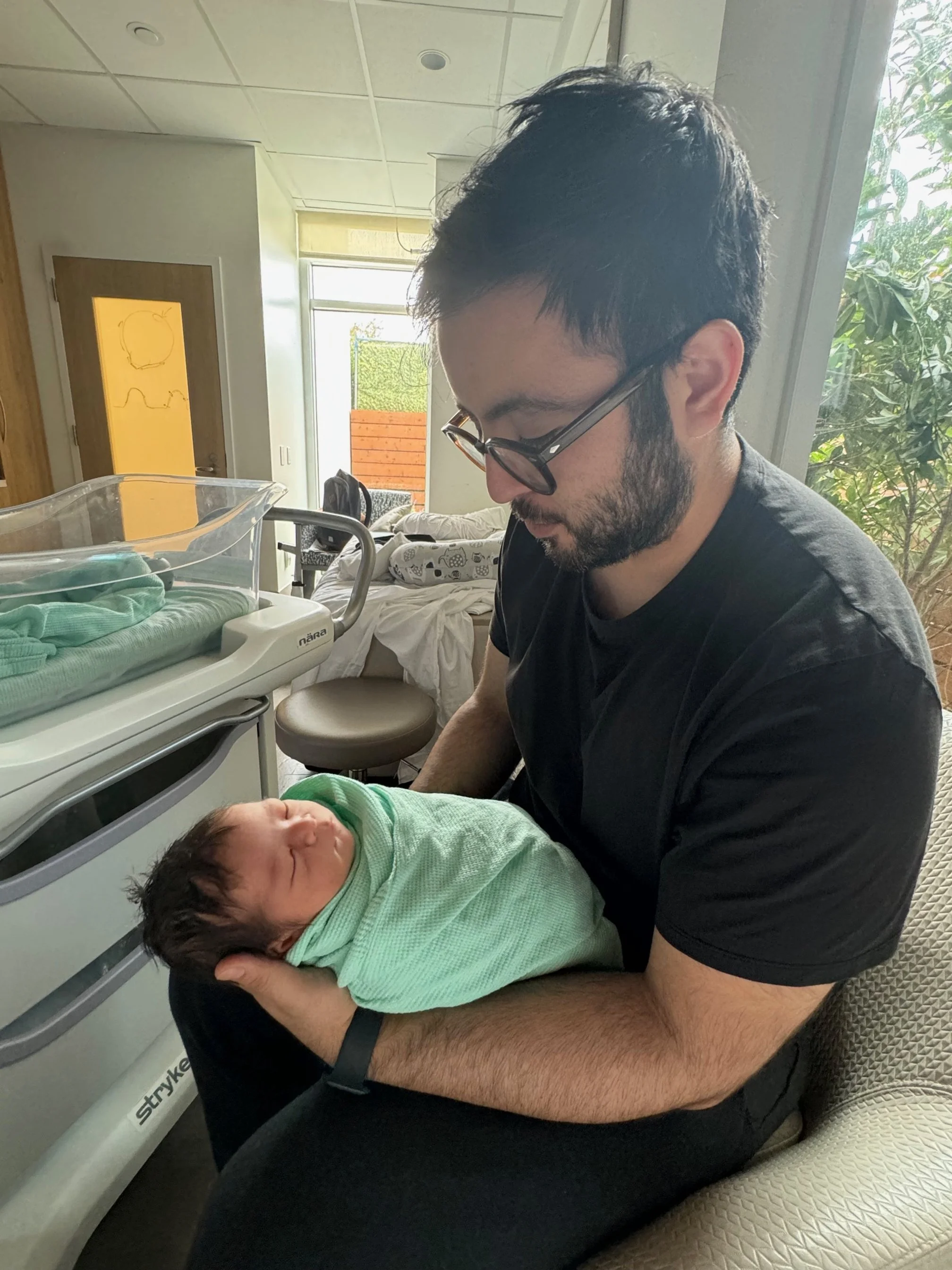My Birth Story: 1 Year Later
Now that Alex is a year old (like wow, can time please slow down a little?!), I finally feel ready to share the story of his birth. Leading up to his arrival—and especially in those early weeks of motherhood—I just wasn’t in the headspace to write, let alone share something so deeply personal. But these days, I feel more grounded, and something in me feels called to put this into words.
I’m sharing this experience not just to document it, but to offer something real for other moms and moms-to-be. Birth is beautiful, but it’s also raw, emotional, and sometimes really hard. My hope is that by sharing my unfiltered thoughts and feelings, someone out there will feel a little less alone in their own “less-than-joyful” moments.
Even as a healthcare professional, this experience reminded me what it means to be a patient—vulnerable, scared, and deeply human. I have so much gratitude for the incredible care team at our hospital. The majority of my pregnancy and labor care was top-tier. But I also had moments during delivery that were hard—moments that took me months to emotionally process. And while they may seem small to someone else, they were significant to me.
Because here’s the thing: birth is deeply personal. It's intense. And sometimes it can feel incredibly isolating—especially when others haven’t been through it or just don’t understand.
Before diving in, I just wanted to lay out a quick trigger warning. This is a birth story, which means there will be mentions of the female body, labor, and delivery. We also had a minor medical event in our experience, so if that makes you uncomfortable, feel free to skip this one.
Pregnancy Recap
I am so grateful to have had a relatively seamless first pregnancy. For the full scoop, you can read about it here! But for a little backstory: I worked with a nursing midwife group connected to a larger hospital in my area. It was a great option for us because it gave us peace of mind knowing we had access to a higher level of care if needed while still embracing the biological wisdom my body was capable of.
Throughout my pregnancy, the care team took time to answer my questions, get to know me and my preferences, and make sure I felt taken care of the entire time. I felt supported, informed, and like an actual person—not just a patient.
Birth Prep & Personal Goals
Trying to find a birth class that worked for our schedules and budget was kind of overwhelming. After some decision fatigue, I landed on the Built to Birth online course by Bridget Teyler in December. Her course/premium membership was on sale, and I loved her message that women’s bodies are made to give birth.
While her course leaned unmedicated/natural, I appreciated that she didn’t shame interventions like epidurals or C-sections—she just emphasized weighing risks and benefits for what feels right to you. I personally took a hybrid approach. I wasn’t tied to rigid rules or expectations, and I wanted to try going unmedicated for as long as possible while giving myself permission to explore other interventions if I felt I needed them.
One of the best things I got from the course was confidence. I practiced breathing techniques and learned pain management tools, and for the first time, I started to feel like, “Maybe I can actually do this.”
Last-Minute Doula
Fast forward to the final weeks of my pregnancy: we were super lucky to find a doula just one month before our due date (s.o. to Jen Ballew from The Parenthood Project). Mario had just started a new job that included doula coverage—so we JUMPED on that. It was such a blessing.
Jen’s support helped ease a lot of the anxiety I was feeling as labor approached. She gave us tools, helped us build a birth plan, and offered a safe space to talk through questions and fears. She also reminded us that birth doesn’t always follow a perfect script. Her calm energy gave me permission to release some of the pressure I had put on myself.
If you’re on the fence about hiring a doula, this is your sign to get the dang doula. They’re incredible and there just for YOU.
The Due Date Came & Went
The 40-week mark came and went—which is super normal for first-time moms. Our original due date was March 11th. I had a feeling I’d go past it, but the anticipation still got to me. I had started maternity leave at 38 weeks to focus on rest and last-minute nesting.
Gentle movement, a clean home, and slowing down helped during that waiting period. I lit candles. I did prenatal yoga. I rearranged the baby’s drawers more times than I care to admit. But with every day that passed after 40 weeks, I felt a little more restless and impatient.
I really wanted labor to start spontaneously. I had heard stories of rough inductions, and I hoped to avoid that route. But my midwives warned me that if I reached 41+6, an induction would be required per hospital policy. That deadline loomed in my head every day.
My Experience with Castor Oil
By March 19th (8 days past due), I was feeling desperate to get things moving. My doula mentioned castor oil as a last resort. I had never heard of it before, and honestly, the research was mixed. But it seemed safe in moderation, with the main side effects being loose stools and dehydration if done in excess.
I mixed 2 oz. into scrambled eggs (which just made for some oily eggs), and surprisingly, it wasn’t too bad. Within a few hours I felt period-like cramps, and later that night, mild contractions began. They lasted on and off for hours, with varying intensity and timing.
I vividly remember tracking the contractions on my phone and quietly wondering if this might be the start of real labor. I didn’t want to get my hopes up, but I was cautiously optimistic.
I dozed off around 10pm and woke back up with stronger contractions around 12:30am. They were lasting up to 90 seconds and coming every few minutes. This went on for about 30 minutes before spacing out again. I stayed up tracking them for a couple more hours. By 7:30am, they were completely gone.
I debated another dose but my gut said no. I listened. It was frustrating to feel like we were making progress only to land back at square one.
Last-Ditch Efforts
By March 21st (10 days past due), I had tried all the things: curb walks, squats, pumping, bouncing on a yoga ball, and finally a membrane sweep at 41+3. At that point, I was 1 cm dilated.
We came into the hospital the next day for a Foley balloon, but it turned out I had progressed to 3 cm, and they felt it would likely fall out. So they skipped it, did another membrane sweep, and scheduled my induction for Sunday, March 24th.
As mixed as I felt about it, I was relieved to have an end in sight. It wasn’t the birth I imagined, but I knew we were taking steps to safely meet our baby. I remember Mario and I sitting in the car afterward, holding hands in silence, both processing the reality that we were about to become parents.
Induction Day
The day had finally arrived. We got to the hospital at 5:30am on March 24th, 2024. Bags were packed. Snacks and drinks were stocked (shout out to Perfect Bars, watermelon juice, and coconut water). I even packed a wooden comb and heating pad—both of which came in handy later.
Our room was beautiful, spacious, and peaceful—exactly the environment I had hoped for. There was soft natural light, comfy pillows, and calming colors. I exhaled deeply just walking in.
Since I wasn’t having regular contractions yet, our doula stayed with another client and would join us later.
They started with Cytotec to soften my cervix. Since I was already 3 cm, the nurses hoped it would be enough to get things moving without Pitocin. I rested, ate breakfast, and passed the time watching TV and napping with Mario.
By 2pm I was having mild contractions every 3-5 minutes and had reached 4.5 cm. Pitocin was offered again, but I opted for using the hospital’s breast pump instead. It worked—briefly. Contractions intensified, but then started spacing out again.
Then… progress! I lost my mucus plug, and my water broke. Because I had tested positive for GBS at 38 weeks, I had to start IV antibiotics. It wasn’t my favorite thing to be tethered to wires, but I understood it was necessary, and thankfully the IV only had to be connected every four hours.
It was around this time I started to feel the shift from early labor into something more real. There was a quiet excitement brewing in the room. I remember turning to Mario and saying, “I think this is actually happening.”
From Early to Active Labor
We gave my body a little more time to see if it would take the lead, but contractions were still irregular. Around 5pm, we started a low dose of Pitocin. To my surprise, it was way gentler that what I had expected based on countless YouTube videos and horror stories I had primed myself for.
By 5:30pm I was at 7 cm. Things were feeling steady and manageable. The nurse mentioned that although my water had broken, there was still a sac present, and the midwife on call (someone I hadn’t met before) offered to break it further. I said no for now—hoping it would rupture naturally.
My doula arrived around 6:30pm, and I was using the yoga ball, focusing on my breath through each wave. I was gripping the wooden comb in my hand, using it as a grounding tool just like we had practiced. Contractions intensified to the point where I couldn’t talk through them anymore, but I still felt like I had control.
I requested to try laboring in the tub, so the nurses brought in an inflatable birthing tub for me to use. It felt amazing to have the weight lifted off my body for a little while. The warm water helped my muscles relax, and for a brief window of time, I could almost zone out between contractions. But after a while, I started noticing things were slowing down again. As wonderful as the tub felt, it was a little too effective in calming my body.
I decided to get out and try something else—anything to keep things progressing. It was around 7:30pm, the nurses had done their shift change, and I was now working with a new set of nurses for the PM shift— p.s. they were equally wonderful like the morning team. The midwife on call finally came back to check on me now that I was in active labor and did another cervical check. To my major disappointment, I was still only at 7 cm dilated. Something she said made it a much harder pill to swallow: “Nothing’s changed, you’re still at 7 cm.” It was the first time that day that I felt discouraged. The midwife had also told me that the sac of water she had felt earlier was still there and that she wanted to break it in order to encourage baby to move down the pelvis.
I reluctantly agreed, and she proceeded to finish breaking my water. From that point on, the mood shifted dramatically. Almost instantly, contractions were happening way more consistently and way more intensely—about every 30 to 60 seconds—and it was the first time I went from feeling bearable discomfort to real pain through each contraction.
Reaching My Breaking Point
There’s a point in unmedicated labor that I learned about in my birth class where things become really primal, and for me, this was that point. I could no longer hold any kind of conversation between each wave of contractions, nor could I just breathe calmly through them. Every contraction required so much mental focus.
I used all the tools in my toolbox—low vocalizations, breathing, the wooden comb to grip, leaning over the yoga ball. It helped to a degree, but the pain was relentless. There were moments I started to have doubts that I could keep going much longer.
This level of intensity continued for the next three hours. Several times, especially toward the end of that stretch, I could feel my body pushing involuntarily. The contractions were so powerful I had no control. The midwife insisted for me not to push since I wasn’t fully dilated, but I could feel my body doing it anyway. At one point she started sounding frustrated, and I remember feeling a wave of anger rise in me. Her tone was sharp and dismissive, and it felt like she was scolding me for something I couldn’t control. I snapped, “I’m not doing it on purpose.” It wasn’t apologetic—it was raw, reactive, and laced with exhaustion. I was doing everything in my power to keep it together, and her lack of compassion in that moment just made everything feel heavier.
At around 10:30pm, the midwife checked me again and said the words that broke me:
"You’re still at 7 cm."
I was crushed. The way she said it made me feel so defeated. I started to question whether I could keep going. I quietly reached for Mario’s arm, looking down at his hand, and whispered that I wanted the epidural. He didn’t hesitate—he told our doula and the nurse, and they got the anesthesiologist right away.
The doctor arrived quickly and worked fast. Within 10-15 minutes, the pain was fading. I felt numbness from the waist down and completely drained. But I could finally breathe again.
The shakes hit me hard— I had uncontrollable shivering from the epidural. No amount of blankets could keep me warm, but eventually my heating pad helped calm them. In that moment, I was so grateful I’d packed it. As things settled, I reflected on the past few hours. Our doula said it seemed like when she broke my water the baby probably dropped really quickly into my pelvis. That sudden descent likely triggered the intense pain and the urge to push. It all happened so fast, and in hindsight, it made sense. But in the moment, it felt like my body had been forced to shift into overdrive without warning.
Emotionally, I was still processing how fast it had all escalated. It felt like I had been thrown into the deep end with no warning— like my body had been rushed.
Getting Some Rest
Once the epidural kicked in, everyone urged me to rest. I was still only 7 cm, and I needed time to progress. Our doula stayed with us for a while, but eventually, she left to get some sleep herself—she’d been up all night with another client.
The night passed in fragments. Nurses came in to check on me, reposition me, and monitor progress. Around 5:30am, they checked again.
"You’re 10 cm. It’s time to push."
The Pushing Stage
Pushing with the epidural felt strange—I couldn’t feel much, so I had to rely on the nurse and midwife to guide me. We turned off the lights and kept the room calm. Mario was next to me, and everything felt peaceful. I knew I was finally going to meet my baby.
After nearly an hour of pushing, the midwife said she could see his head. She let me reach down and feel it. It was surreal. The plan was for Mario to catch the baby, and he was standing nearby, ready for his moment.
Then something shifted. The midwife told me to stop pushing.
"What do you mean stop?" I thought.
The energy in the room changed. She adjusted her posture, called out something to the nurse next to her, and told us that Alex’s shoulder had gone back into the birth canal. She needed to perform a maneuver to help guide him out. Mario wouldn’t be catching him anymore. She warned that a team would be coming in to assess him immediately after birth.
I was confused. Disoriented. I had been so focused on pushing that I didn’t understand the urgency building around me, nor did I even really register what she said.
Alexander Arrives
6:23am on Monday March 25th, 2024:
Alexander Milan Ibarrola Garcia (Korean name: Jang-Eun 장은) was born.
For one brief moment, he was placed on my chest. I remember thinking, “My baby is here. He’s so perfect.”
Then the blinding lights came on. A swarm of 10-15 people rushed into the room. The midwife told me they had to take him to the warmer table.
I started to panic. I couldn’t see him. There was so much commotion. Mario was narrating what he could see, but I could tell he was overwhelmed too. I started crying uncontrollably, and in that moment all I could do was pray.
They dried him off, gave him oxygen, and started suctioning. After a minute or two, he let out a cry. His color returned. There was a collective sigh of relief.
Shoulder Dystocia & NICU
The midwife explained that Alex had experienced shoulder dystocia—when one of the baby’s shoulders gets stuck after the head is delivered. She said his first shoulder came out, then slipped back in after a round of pushing, which caused the complications.
He needed to be taken to the NICU for observation as a precaution. I told Mario to go with him to keep me posted. Those next two hours were a blur of crying, getting stitched up, and praying that he was going to be okay.
Mario updated me from the NICU—Alex was stable, breathing well, and doing fine. I was physically and emotionally wrecked, but hearing he was okay helped me start to come back to myself.
After a few hours, they finally brought him back to our room.
Reunited at Last
Seeing his crib roll through the door was the best moment of my life. I felt whole again. I held him on my chest, kissed his little head, and everything finally clicked into place.
He was here. Safe. Ours.
We stayed one more night in the hospital to rest, recover, and soak in our first full day together as a family of three. It felt like a much-needed pause after such an intense experience. By the next day, we were discharged and heading home—finally ready to bring our baby boy back to the comfort of our own space.
Final Thoughts
If you’ve made it this far—thank you for reading.
As I reflect on this experience nearly a year later, I’m filled with so many emotions—gratitude, pride, and a sense of awe for what our bodies and hearts are capable of enduring. I wanted to wrap up by sharing a few key takeaways from this journey:
Be kind to pregnant & laboring women. Labor and delivery is such a vulnerable and intense experience—emotions and hormones are heightened, and fear can creep in even in the most prepared minds. A little compassion and gentleness can go a long way, especially from those in positions of care.
Snacks are essential. I overpacked a lot of things, but the nourishing snacks we brought ended up being incredibly helpful during labor and recovery.
Be your own advocate. Speak up. Ask questions. Don’t hesitate to share your preferences or concerns with your care team. You know your body and your values best.
Support matters. Whether it’s your partner, a doula, or a trusted provider, having people who listen and respect your wishes can make all the difference.
Birth may not go as planned—and that’s okay. The experience might look different than you envisioned, but that doesn’t take away from the strength it takes to get through it.
Your story is valid. No matter how smooth, complicated, joyful, or emotional it was—your birth story is worth telling.
If anything here resonated with you or brought up your own memories, I’d love to hear from you. Every story is different—and worth sharing. 🤍


